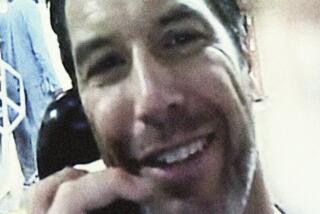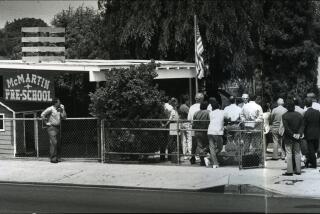Jurors Asked to Look Into Mind of a Killer
- Share via
SAN JOSE — This much is certain: Cary Stayner committed a heinous crime, slaying three vacationers outside Yosemite National Park in 1999.
What remains to be settled is whether the motel handyman was in his right mind when he did it.
After five weeks of trial, Stayner’s sanity is the salient issue as a nine-man, three-woman jury prepares for closing arguments this week in a wood-paneled courtroom in San Jose.
They’ve already heard more than two hours of Stayner’s taped confession, his chilling description of how he used the ruse of a leaking pipe to get into the motel room of his victims: Carole Sund of Eureka; her 15-year-old daughter, Juli; and a family friend, Silvina Pelosso, 16.
Stayner, who has pleaded not guilty by reason of insanity, plugged his ears with his fingers while the tape played.
But the trial has been dominated as much by psychiatric jousting as by physical evidence. At stake is whether Stayner should be put on San Quentin’s death row.
A parade of mental-health professionals has detailed a disturbing childhood. There has been talk of psychotic behavior, of Stayner’s predilection to pull out his hair, of daydreams about rape and torture.
Jurors have heard experts in nuclear medicine debate Stayner’s brain composition. They have gazed for hours at color slide projections of cranial cross sections, sliced up like potato chips.
All this has left the families of the victims angry and troubled.
“The horrible part for us,” said Francis Carrington, father of Carole Sund and grandfather of Juli, “is to sit through weeks and weeks and weeks of psychiatric testimony that doesn’t get to the nugget--this man killed four women brutally and with a level of careful planning that makes him seem all too sane.”
It began in February 1999, when the Sunds and Pelosso went missing from their room at the rustic Cedar Lodge in El Portal, a tiny community nestled in the deep gorge where the Merced River pours from Yosemite’s valley floor.
One of the biggest manhunts in state history ended four weeks later and a county away, when the torched hulk of the women’s rental car was discovered on a forest logging road with the charred remains of two of the victims in the trunk. An anonymous note--Stayner later admitted to having dispatched it, even to having asked someone else to lick the stamp--led authorities a week later to the shore of a nearby lake, where they found the nude body of Juli Sund, her neck sliced open.
Five months after the tourists went missing, Joie Ruth Armstrong, 26, became Stayner’s fourth victim. The Yosemite naturalist’s beheaded body was found near her cabin in a remote corner of the park in July 1999.
Within days of that gruesome killing, authorities caught Stayner. He pleaded guilty in federal court to Armstrong’s murder to avoid the death penalty. But state prosecutors pressed ahead with their death-penalty case.
Intended Victim Testifies
Under intense media scrutiny, the trial was moved from Mariposa County to San Jose. Television news crews and reporters flooded the start of the trial July 15 at Santa Clara County Superior Court. The judge is Thomas Hastings, the same jurist who presided over the death penalty trial of Richard Allen Davis, who killed 12-year-old Polly Klaas in a widely publicized 1993 case. Hastings established a yellow tape line outside the courthouse, marking where interviews could be conducted, so jurors wouldn’t be tainted by overhearing them.
Since those circus-like opening days, the criminal court fight has trundled on in front of scant spectators and only a handful of newspaper reporters.
Prosecutors took about seven days to lay out their case in exhaustive detail. They called 30 witnesses, including a teenage girl Stayner had intended to be his first victim. He decided not to strike after discovering that the girl’s father was staying at the Cedar Lodge, where Stayner worked as a handyman.
George Williamson, the lead prosecutor in the case, described Stayner as a methodical killer who carefully hatched a plan to hunt down young women like prey, sexually assault them and then kill them. Stayner, he noted, had gone to the trouble of leaving wet towels in the motel room to make it look as if the three women had showered and left.
The defense team conceded from the beginning that Stayner had killed the three tourists. Attorneys Marcia Morrissey of Los Angeles and Michael Burt of San Francisco zeroed in on Stayner’s mental health, trying to portray a twisted mind incapable of the forethought and intent needed to justify a conviction for first-degree murder.
“They seem to want to demonstrate that he is seriously mentally ill, and that we shouldn’t execute someone who is seriously mentally ill,” said Donald Heller, a Sacramento criminal defense attorney following the case.
If the jury finds Stayner guilty of the murders, it will be asked in a second phase of the trial to determine whether he was sane when he committed them.
Morrissey has argued that Stayner kept his mental disorders in check for decades, but eventually succumbed to inner demons in the months before the Yosemite slayings. His mind, Morrissey said in court, had “broken down. There was no right or wrong for him.”
Psychiatrists who examined Stayner said he had experienced vivid imagery of sex and violence since an early age. His family tree is littered with relatives who suffered from mental illnesses, including depression and pedophilia, they said.
And tragedy dogged his family life. Stayner’s younger brother, Steven, was abducted at age 7 by a pedophile and held as a sex slave for seven years before escaping. Steven Stayner later died in a motorcycle accident.
As an adult, Cary Stayner had a fixation on Bigfoot and the apocalyptic prophesies of the 16th century astrologer Nostradamus, one psychiatrist testified, and had nightmares of being pursued by disembodied heads.
Dr. Jose Arturo Silva, a court-appointed forensic psychiatrist, testified that Stayner--who had been molested by an uncle in his youth--showed signs of pedophilia, voyeurism, social dysfunction and other disorders. Silva said Stayner dreamed about watching neighborhood girls being raped. Sometimes he envisioned himself rescuing the girls; other times he joined in the rapes, Silva said.
Was His Brain Damaged?
After the defense played a portion of Stayner’s taped confession, in which he bartered with FBI interrogators for child pornography in exchange for telling all, Silva suggested those demands demonstrated his many psychoses.
Experts also testified that Stayner’s brain may have been damaged when his mother fell during a softball game while pregnant with him. Stayner, they said, has a visibly misshapen head. One neuropsychiatrist testified that his brain was probably damaged in a region that controls emotional impulses.
As part of the defense, Stayner underwent a positron emission tomography, commonly known as a PET scan, at the UC Irvine brain imaging center.
Dr. Joseph Wu, the center’s clinical director, testified that Stayner had abnormalities in several portions of his brain.
Prosecutors countered with Dr. Alan Waxman, a USC clinical professor of radiology.
Waxman, who often battles Wu in criminal court cases over the use of PET scans to correlate mental abnormalities with criminal behavior, said Stayner’s brain appeared normal when compared with those of 56 other people.
More to Read
Sign up for Essential California
The most important California stories and recommendations in your inbox every morning.
You may occasionally receive promotional content from the Los Angeles Times.










